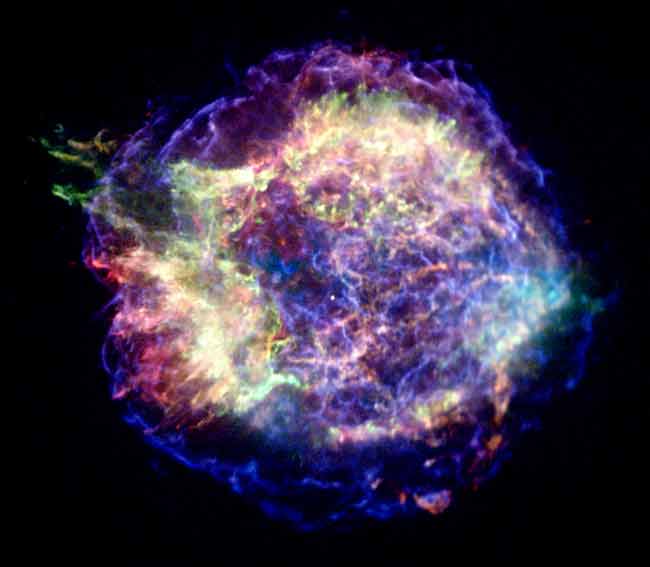Astronomers Describe Cosmic Pinball Machine

New cluesthat cosmic rays, high-energy particles that travel space and bombard theEarth, are generated by shockwaves in supernova remnants were revealed by a new study using NASA's ChandraX-ray observatory.
Cosmicrays are composed of high-energy electrons, protons and ions. Scientistsused the Chandra observatory to study the X-raysemitted by the electrons (the only one of the particles that emits X-rays) fromcosmic rays emanating from CassiopeiaA, a 325-year-old supernova remnant.
Scientistshave long theorized that the high-energy shock waves of exploded stars called supernovas,were among "the few places in the galaxythat have enough energy to accelerate these particles," said Michael Stage, anastronomer at the University of Massachusetts, Amherst.
Theytheorize that the particles, contained by magnetic fields on either side of theshock wave, bounce back and forth across the shock, eventually energizing theelectrons to very high energies.
"Theelectrons pick up speed each time they bounce across the shock front, likethey're in a relativistic pinball machine," said Glenn Allen, a team memberfrom the Massachusetts Institute of Technology. "The magnetic fields are likethe bumpers and the shock is like a flipper."
Oneimportant key for this theory to work, Stage says, is that the acceleration ofthe particles should come close to the theoretical maximum rate. The images ofX-ray radiation from Cassiopeia A allowed the scientists to map out theaccelerations of the electrons and provided "direct evidence that [thismaximum] is reached for electrons," Stage told SPACE.com.
Stage saysthat it is likely that protons and ions would be accelerated in the same way asthe electrons.
Breaking space news, the latest updates on rocket launches, skywatching events and more!
By lookingat the X-ray images, scientists also observed that the highest-energy electronsaccelerated very quickly to their energies, whereas lower energy electrons tookmuch longer to accelerate.
Accelerationof charged particles also occurs in shocks in the Earth's magnetosphereand in jetsproduced by supermassiveblack holes.
"Explainingwhere cosmic rays come from helps us to understand other mysterious phenomenain the high-energy universe," Stage said.
- Cosmic Rays Linked to Supernova
- Exploded Star Detailed in New X-ray Image
- Supernova Shock Wave Captivates Astronomers
- Top 10 Chandra Pictures: Four Years of X-ray Imaging
- Inside the Mission: The Chandra Observatory

Andrea Thompson is an associate editor at Scientific American, where she covers sustainability, energy and the environment. Prior to that, she was a senior writer covering climate science at Climate Central and a reporter and editor at Live Science, where she primarily covered Earth science and the environment. She holds a graduate degree in science health and environmental reporting from New York University, as well as a bachelor of science and and masters of science in atmospheric chemistry from the Georgia Institute of Technology.
